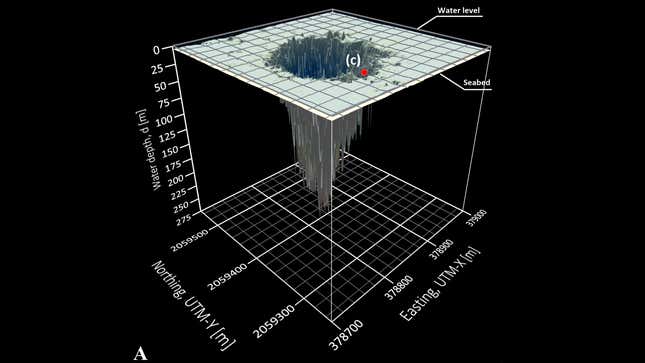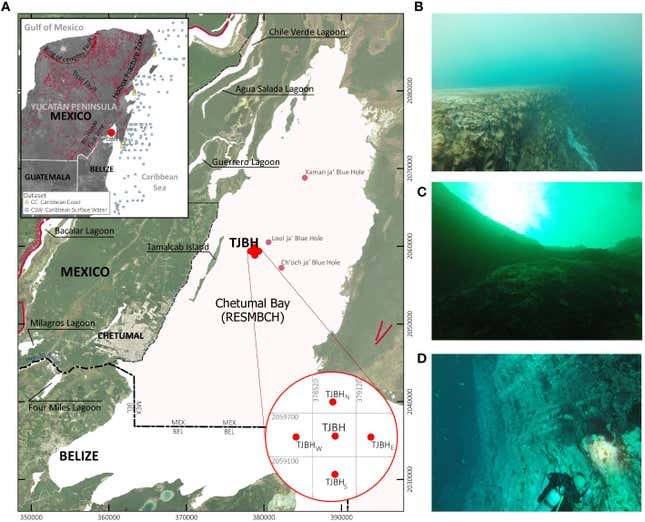Researchers have discovered a blue gap they are saying is the deepest on the earth—they usually’ve but to search out the place it bottoms out. The formation is the Taam Ja’ Blue Gap in Mexico’s Chetumal Bay, and it has thus far been measured to 1,378 toes deep, or 420 meters beneath sea degree.
Blue holes are big underwater sinkholes that seem on the seafloor when the limestone bedrock collapses. A few of the most well-known blue holes are off Central America, particularly Belize’s Nice Blue Gap. Taam Ja’ is close to the border of Mexico and Belize, off of Mexico’s Tamalcab Island and near a number of different blue holes in Chetumal Bay. Measurements of the outlet’s depth and the way present circulates via it have been printed this week in Frontiers in Marine Science.
Taam Ja’ usurps the South China Sea’s Dragon Gap (additionally referred to as the Sansha Yongle Blue Gap) because the deepest recognized blue gap. The Dragon Gap is about 990 toes deep, surpassing the third-deepest blue gap, Dean’s Blue Gap, by over 300 toes. The Taam Ja’ Blue Gap is greater than twice as deep as Dean’s Blue Gap.

In December 2023, the staff measured the sinkhole utilizing a CTD (conductivity, temperature, and depth) profiler, a collection of digital devices that might characterize a number of elements of the sinkhole. Evaluating hydrographic information from the sinkhole with water layers in different reef lagoons, estuaries, and barrier reefs in Central America and the Caribbean led the staff to conclude that “potential subterranean connections” could exist within the gap’s depths.
The CTD additionally revealed a rise of water temperature and salinity within the gap round 1,312 toes (400 meters) beneath sea degree. The nice and cozy water could also be associated to volcanic or tectonic processes or geothermal exercise at depth, the scientists concluded.
The researchers emphasised that the outlet could also be a lot deeper than their current measurement, primarily based on the construction of inland limestone cave techniques. The staff particularly referenced Krubera-Voronya, the deepest-known cave, which is 7,188 toes (2,191 meters) deep.

“This evinces the wants of steady exploration of those karst geological constructions, their intricate geomorphology, and the event of cave branches,” the examine authors wrote. “Delving into the underwater spatial geomorphology of TJBH, the main focus is on deciphering its most depth and the probabilities of forming a part of an underwater intricate and probably interconnected system of caves and tunnels.”
The researchers didn’t define particular plans to remeasure Taam Ja’, however their investigation of its depth was solely stopped by technological limitations. They outlined that future investigations of the outlet “ought to incorporate superior underwater navigation applied sciences” to higher discover the mysterious—and hitherto unknown—depth of the eerie gap.












Leave a Comment